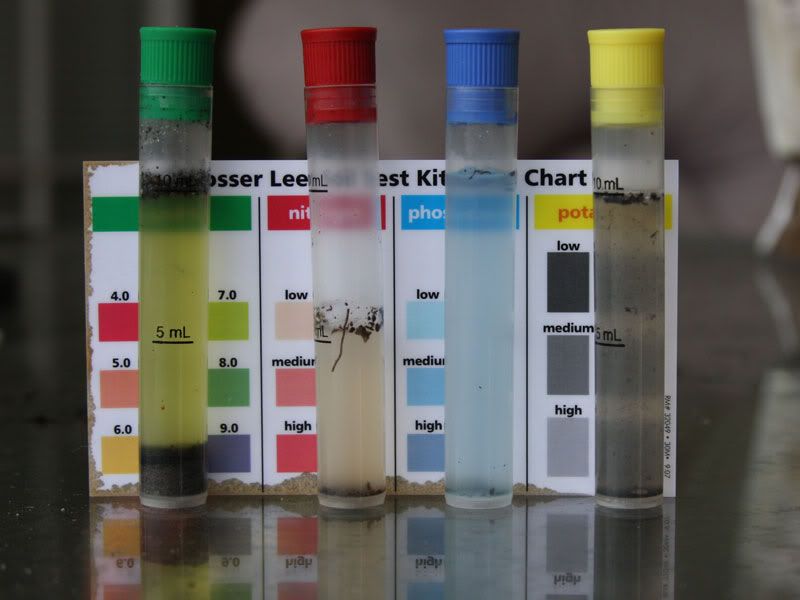I decided that instead of blaming myself for the lackluster plant growth, I'll pass the buck and blame the soil again. I quite enjoy feeling like a victim of crappy soil so it pleases me to test the soil so I have proof of my victim status. Last night I decided to whip out the soil test we purchased last year and retest our soil pH, Nitrogen, Phosphorus and Potassium. I'll admit to thinking our soil is probably about average, after all, it actually looks like soil this year and we added some old manure a few months ago, so I figured the results might be a little off, but nothing dramatic.
Oh how I fall for it every single time. We have drama. Major soil drama. It's a barren wasteland cleverly disguised as soil and I am flying my bad-soil-victim flag high now that I have these results in my hands.

As far as I can tell our pH seems okay. When we took a soil sample to the extension office we got a result of 6.5. We added a very thin layer of lime at their suggestion and according to the soil test, it does seem a little lighter than the green square next to 7.0, so I'd guess that means the soil pH is still okay.
Look at that Nitrogen. The test says to "match pink color to the Nitrogen Color Chart," but as you can see I don't have any pink - at best it's hovering around low. I think that means our soil is pretty devoid of nitrogen. I don't know much about these results, but I know enough to know that plants need Nitrogen if they're going to live longer than five minutes.
Now let's look at the Phosphorus. It doesn't seem to quite register on the chart either. It looks like the blue is lighter than the lightest blue on the chart too. I'll admit to having no earthly idea what low Phosphorus meant, but after reading about it online I discovered its necessary for good root development and for fruit and seed production.
Finally the Potassium. I had trouble reading the Potassium results last time and I'll admit to being a bit iffy about what they read this time. I'll venture a guess that our Potassium is right about medium, but I can't be sure. I find it hard to believe that it's in the middle range, but I'm going with it because it makes me feel good to have something actually fall within mid-range on the chart.
I think the grand results mean I have some pretty sandy nutrient-free soil and a gardenful of plants who are starving to death. I'm thinking my light spraying with fish goo didn't fix it all. Instead I'll need to find out what fertilizer product to buy, where to apply it and how often to apply it. The worst part about the results? They look exactly the same as the results from when we first dug out the garden last year. So here we are almost a year later and nothing has improved. I really do feel like I'm constantly fighting an uphill battle with this garden, but I'm determined to beat it.




















7 comments:
Don't feel discouraged. My clay soil out here in Santa Barbara, CA gets amended (back breakingly so) every spring, only to find later that my plants die off because my soil fails the tests too. I rotate crops, compost, etc. and results are the same every year. Have not tested yet this year and the garden is still in juvenile stages, so maybe this year.....
Kate - No big deal, it can easily be corrected.
Nitrogen is typically the only major nutrient that has to be added each year in most gardens, because it doesn't stay in the soil very long. The other major nutrients (Phosphorous and Potassium) don't need to be added very frequently - and can become a problem if they are added year after year. Especially Phosphorous....
Anyway, since you need some nitrogen and phosphorous, there's two ways you can do it...organic and synthetic.
To increase nitrogen -
Organic - blood meal
Synthetic - ammonium sulfate
To increase Phosphorous -
Organic - Bone meal
Synthetic - Super phosphate
Let me know if you need more info, but I know others will chime in, as well.
The entire soil testing is way beyond me.
raised beds...filled with 100% compost...get a truckload delivered, it's cheap (35-40 bucks)! This is the only way I get lush veggies as our soil is all sand. Just make sure what you are getting is indeed compost, and not "composted mulch"! I found out that my 3 beds that killed my tomatoes was due to compost delivered that was not legit! I will be posting my results of that fiasco later this week on my blog. But all my other beds have 100% compost (no soil), haven't even added to them for the past 3 years and the veggies are lush and productive. Good luck!
Sorry about the soil tests. I do not know what to do to fix your problem however I think there are things you can add to the soil to increase or decrease any of the nutrients. Becca
Good compost will go a long way to resolving your soil problems. Just keep adding organic matter to your soil. If you don't like to grow your own compost, you can sometimes get it for free or cheap. A way you might like is the Ruth Stout method. Lay several inches of hay or straw on the soil and tuck your potato peelings, onion skins, banana peels and so on under the mulch. Nature will break it down in due course.
Feeding the soil will build a healthy population of microbes and other organisms that will make the nutrients in the soil available to the plants. Chemical fertilizers will give your plants the major components they need, but will not promote soil health. It would be like trying to raise a child while feeding only french fries, coca cola and chicken nuggets and nothing else. The child won't starve to death, but won't be getting all that he should.
You might consider planting a cover crop in the fall and cutting it down and smothering it in the spring. That would add a lot of organic matter to the soil and if you pick a legume and leave the roots in the soil, that will add a lot of nitrogen to the soil.
Could the reagents in the test kit be bad?
Post a Comment